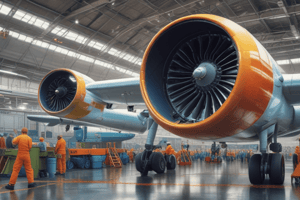Podcast
Questions and Answers
What percentage of a modern full-loaded subsonic transport's total weight is payload when taking off?
What percentage of a modern full-loaded subsonic transport's total weight is payload when taking off?
- 30%
- 40%
- 20% (correct)
- 50%
Why is the use of light materials important in aircraft design?
Why is the use of light materials important in aircraft design?
- To increase structural strength and reduce flight range
- To reduce structural weight and increase payload (correct)
- To decrease structural strength and increase stability
- To increase structural weight and reduce fuel consumption
What does the aircraft manufacturer's heavy investment in weight reduction primarily indicate?
What does the aircraft manufacturer's heavy investment in weight reduction primarily indicate?
- The priority of increasing power requirements
- The emphasis on increasing structural weight
- The focus on increasing fuel consumption
- The importance of saving in aircraft weight (correct)
What type of materials do airframe designers demand for aircraft structural design?
What type of materials do airframe designers demand for aircraft structural design?
For what purpose do significant parts of the airframe emphasize stability considerations?
For what purpose do significant parts of the airframe emphasize stability considerations?
What is the percentage of the remaining 80% of the full-loaded subsonic transport's total weight, after considering the payload, that is attributed to aircraft empty weight?
What is the percentage of the remaining 80% of the full-loaded subsonic transport's total weight, after considering the payload, that is attributed to aircraft empty weight?
What is the expected life in hours for military fighters?
What is the expected life in hours for military fighters?
Which material is having a major effect on aircraft design?
Which material is having a major effect on aircraft design?
What type of materials are thermoplastic composites?
What type of materials are thermoplastic composites?
What are the principal materials in airframe design?
What are the principal materials in airframe design?
Which material has improved properties based on its lower density?
Which material has improved properties based on its lower density?
What are the expected weight savings with the use of composite materials?
What are the expected weight savings with the use of composite materials?
What does tension and compression coupon tests provide fundamental information on?
What does tension and compression coupon tests provide fundamental information on?
What is the major effect of weight savings in aircraft design?
What is the major effect of weight savings in aircraft design?
What properties does the designer require data on prior to material selection?
What properties does the designer require data on prior to material selection?
Which materials will probably continue to be the principal materials in airframe design for a while?
Which materials will probably continue to be the principal materials in airframe design for a while?
Flashcards are hidden until you start studying
Study Notes
Subsonic Transport Weight Considerations
- Payload accounts for approximately 20% of a modern fully-loaded subsonic transport's total weight at takeoff.
- After deducting the payload, 80% of the total weight is attributed to the aircraft's empty weight.
Importance of Lightweight Materials
- Utilization of lightweight materials is crucial for reducing overall aircraft weight, enhancing fuel efficiency, and improving performance.
- Airframe designers seek materials that provide high strength-to-weight ratios to optimize structural integrity while minimizing weight.
Impact of Manufacturer Investments
- Aircraft manufacturers heavily invest in weight reduction technologies, indicating a prioritization of fuel efficiency and operational cost savings.
Demand for Specific Materials
- Airframe designers require advanced composite materials and alloys that can withstand high stress while remaining light.
- Thermoplastic composites, known for their moldability and ability to recycle, represent a novel category of materials used in aircraft.
Stability in Airframe Design
- Significant parts of the airframe are designed with stability considerations to ensure safety and control during flight operations.
Material Characteristics and Savings
- Composites offer substantial weight savings compared to traditional materials, typically ranging from 20% to 30%.
- The principal materials in airframe design include aluminum alloys, titanium, and composite materials, all contributing to enhanced performance.
- Lower density materials improve overall aircraft efficiency by reducing weight while maintaining structural capabilities.
Testing and Selection Data
- Tension and compression coupon tests provide essential data on material properties such as strength, ductility, and fatigue resistance, guiding selection processes.
- Designers require comprehensive data on mechanical properties, such as tensile strength, fatigue limits, and thermal stability, before selecting materials for aircraft design.
Future Material Trends
- While advanced composites are emerging, aluminum and titanium alloys are expected to remain the principal materials in airframe design for the foreseeable future.
- Military fighter aircraft are expected to have an operational life of around 5,000 to 10,000 hours, emphasizing the need for durable materials.
Studying That Suits You
Use AI to generate personalized quizzes and flashcards to suit your learning preferences.




